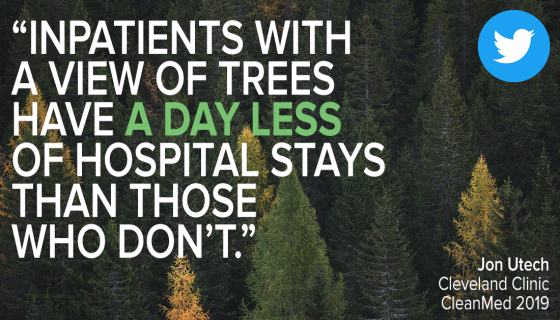New tree planting program for hospitals

Health care promoting healthy cities by planting trees
Studies show that patients who have a view of trees spend fewer days in the hospital than patients who don’t.
But that’s not the only way trees improve health. One organization is making it their mission to combat several health challenges, like mental health and pollution, through the simple act of planting a tree.
Arbor Day Foundation – a nonprofit organization founded in 1972 – aims to plant not just one tree, but millions. The foundation has a long history of incentivizing community forestry practices. For years, the nonprofit has led several recognition programs, including Tree City USA, Tree Campus USA, and Tree Line USA.
And this fall, they’re partnering with health care organizations to tackle issues like increasing temperatures and unsafe outdoor spaces.
Launching the program
Tree Campus Healthcare – a new program that focuses on the role of health care in bolstering tree cover – launched at CleanMed in May. The program will work with inpatient health facilities in the United States by partnering the institutions, like hospitals and senior care facilities, with forestry programs to expand the number of trees on their campuses. The program will create incentives for health facilities to work with local forestry organizations to build a healthier environment and support urban forests.
“We ultimately are trying to impact the health of the population that we serve,” said Jon Utech, Cleveland Clinic Office for a Healthy Environment senior director. “We also want to inspire others to follow us since improving air quality, reducing carbon pollution, and improving water quality benefits everyone and can be accomplished through tree planting.”
Applications for Tree Campus Healthcare opens Sept. 3. Each partnering health care organization will receive annual recognition if they meet five standards.
5 standards
Dan Lambe, the president of Arbor Day Foundation who spoke at CleanMed, said Practice Greenhealth, Health Care Without Harm, and Cleveland Clinic worked with Arbor Day Foundation on the creation of standards for the new Tree Campus Healthcare Program. The nonprofit also worked with several partners, including the United States Forest Service, Davey Tree, and the Professional Grounds Management Society, to create the new standards.
-
Unite: Each partnering institution is required to have an advisory committee made up of at least three members, including health professionals and other employees. “While the responsibility for care of trees at the facility may ultimately lie with the facility grounds manager, the advisory committee can provide input on future plantings and advocate for a sustainable tree care plan for the campus,” the website states.
-
Plan: Each health care institution must also create a plan that articulates how the trees will be cared for and set goals around tree planting and management.
- Lead: Each health care institution will create, lead, or fund a community forestry project, like tree giveaways or collaboration on a project with a Tree Campus University or Tree City partner.
- Educate: Each participating institution is asked to sponsor a celebration event or an awareness campaign, like an Arbor Day celebration at the hospital or a “walk with a doc” in a park.
- Invest: Health care facilities must track investments related to the tree plan and in-kind contributions in meeting the Tree Campus Healthcare standards.
Improving health and fighting climate change
Lambe said many hospitals in the United States are already planting trees to improve the health of their patients. He added that in addition to providing beauty to the grounds of a hospital, trees promote health and general well-being.
“This isn’t just about celebrating beautiful grounds – it’s about encouraging wellness in our communities,” Lambe said at CleanMed.
Planting trees also reduces the amount of carbon dioxide in the atmosphere. Afforestation – planting trees in areas where tree cover was limited or did not exist – is ranked as the 15th solution in mitigating climate change, according to Project Drawdown. In fact, the Earth is capable of supporting 0.9 billion hectares – equivalent to about 1 billion football fields – of trees outside of developed areas. That many trees could store more than 200 gigatons of carbon. The United States alone has the potential to host more than 100 million hectares of trees, according to a recent study.
“Tree planting programs reduce carbon, increase climate change resilience, and improve overall community health,” said Lauren Koch, the associate director of climate and health at Health Care Without Harm and Practice Greenhealth. “This is a win-win strategy for our hospitals.”
To learn more, visit the Arbor Day Foundation website.
Jessica Wolff, Jon Utech, and Dan Lambe, launched Tree Campus Healthcare at CleanMed 2019. Photo courtesy of Arbor Day Foundation.
This post was written by Leah Potter, a Health Care Without Harm intern and George Washington University student.
Join Practice Greenhealth
Practice Greenhealth is the health care sector’s go-to source for information, tools, data, resources, and expert technical support on sustainability initiatives that help hospitals and health systems meet their health, financial, and community goals.

